0x05-自用子弹笔记指南
Basic | 基础¶
Symbols | 符号¶
Bullets
子弹笔记里有三种原子符号:任务、笔记、事件
- Task: •
- Notes: ⁃
- Event: ○
这里其实也可以使用 HTML 符号编码转译下,我是用 Mac 系统下自带的特定字符敲出来的
Tasks
- • 这是一个待完成的任务
- ✕ 这是一个完成的任务
- > 这是一个被迁移到另外一个集子中的任务
- < 这个是一个被安排到未来日志中的任务
这是一个被删除的任务
Date
month
- 一月:January Jan
- 二月:February Feb
- 三月:March Mar
- 四月:April Apr
- 五月:May May
- 六月:June Jun
- 七月:July Jul
- 八月:August Aug
- 九月:September Sep
- 十月:October Oct
- 十一月:November Nov
- 十二月:December Dec
week
- Sun
- Mon
- Tue
- Wed
- Thu
- Fri
- Sat
format:
Sun,Jan 1/Jan 1:
Event¶
- ○ @张三 的生日
- ○ 看电子竞技比赛
- ○ 浇花
- ○ 看美剧「sameless」
Traslation¶
will transform your life, in more ways than you can imagine." – Hal Elrod, Author of The Miracle Morning
Rapid Logging | 快速记录
Be it for taking notes or journaling, studies keep identifying benefits of writing by hand. That said, it takes time and can be unorganized. How can we enjoy the benefits while avoiding the shortcomings of hand writing? Rapid Logging.
Rapid Logging is the language in which the Bullet Journal is written. In short, it’s a way of capturing information as bulleted lists. Let's start with the basics.
无论是做笔记还是写日记,不段有研究表明手写的好处。话虽如此,但它需要时间,而且可能没有条理。如何才能在享受好处的同时避免手写的缺点呢?快速记录。
快速记录是 Bullet Journal 的写作语言。简而言之,它是一种以子弹集子的方式采集信息的方法。我们先从最基本的开始说起。
Bullets | 子弹
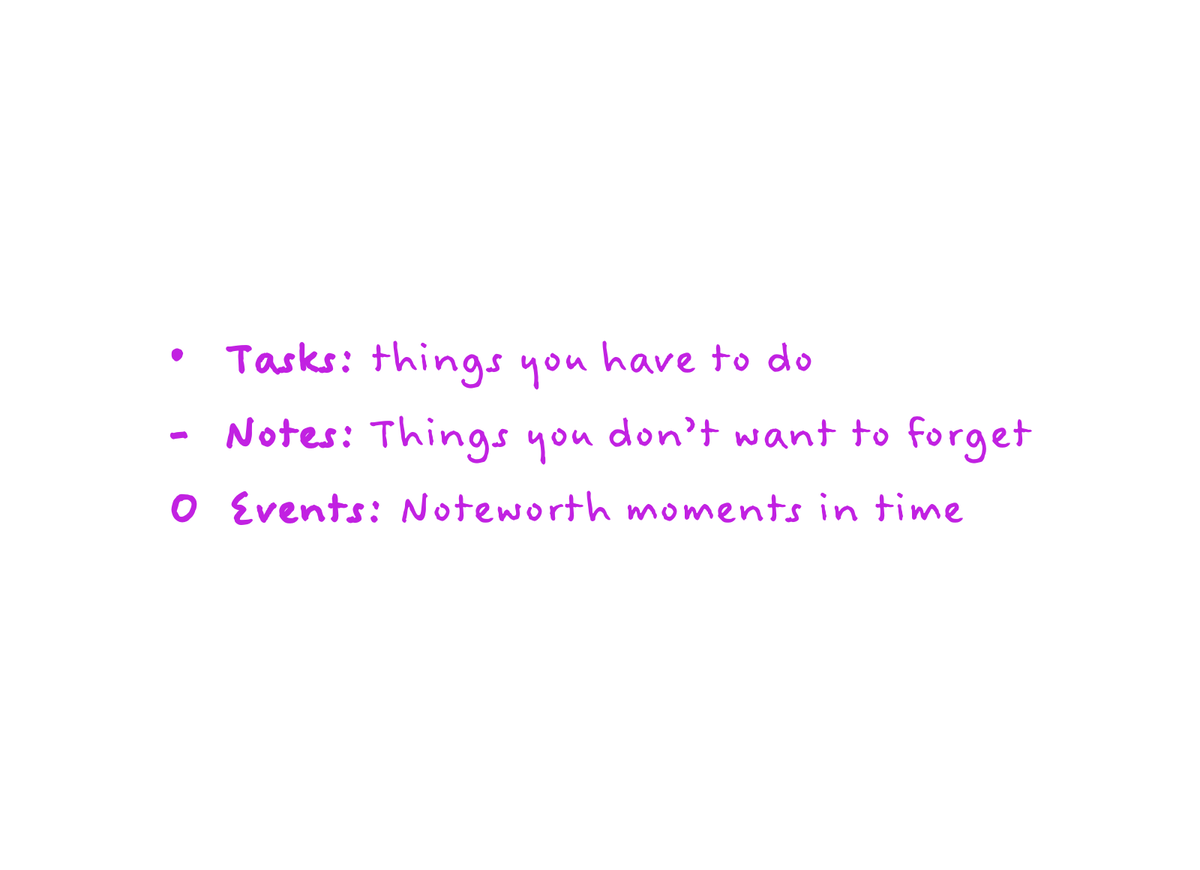
If Rapid Logging is language the BuJo is written in, Bullets are the syntax. Bullets are short-form sentences paired with symbols that visually categorize your entries into: Tasks, Events, or Notes. Let's break it down...
如果说快速记录是 BuJo 的写作语言,那么 Bullet 就是语法。Bullets 是简短的句子,配上符号,直观地将你的条目分类为:任务、事件或笔记。让我们来分析一下...
Tasks | 任务
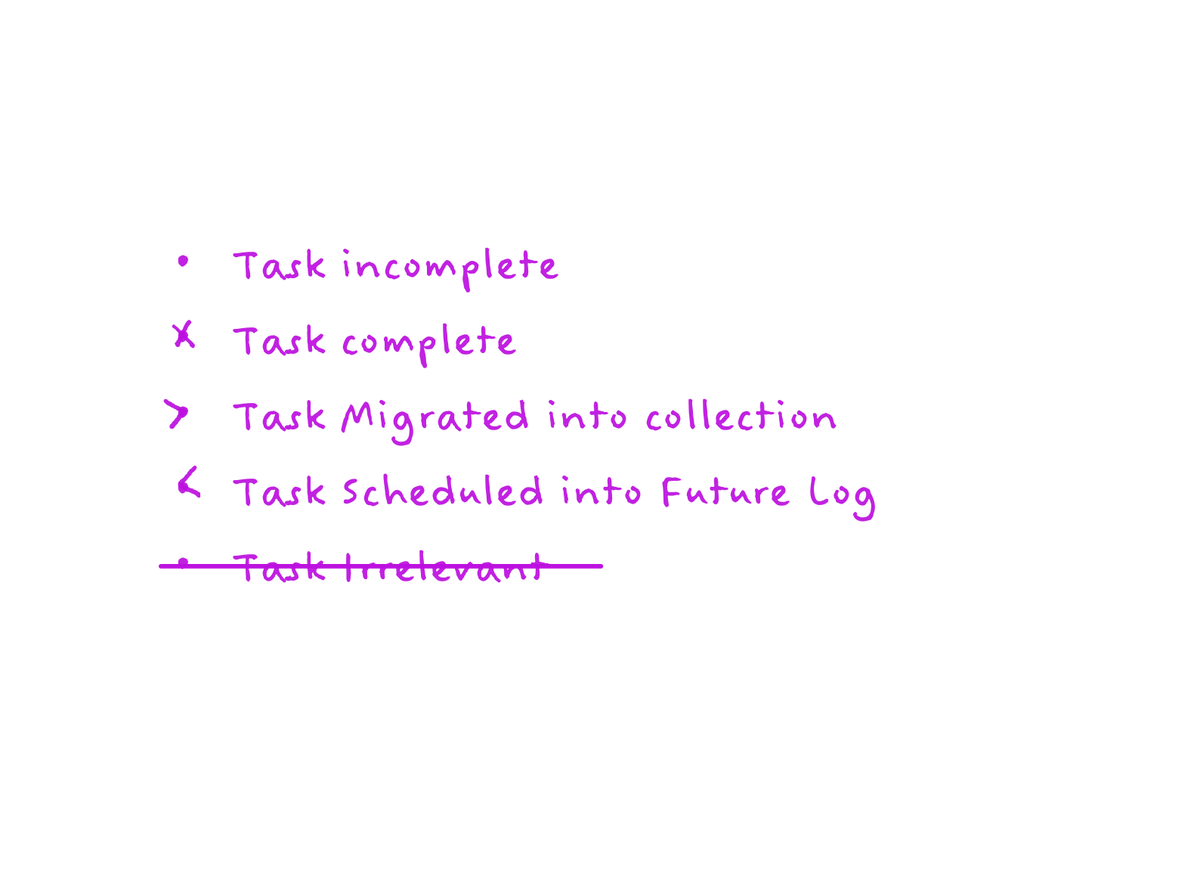
Tasks are represented by a simple dot "•". We use a dot instead of a checkbox because it's fast, clean, and can easily be transformed to reflect the state of the Task. Tasks can have one of five states.
任务用一个简单的点表示。我们使用圆点而不是复选框是因为它快速、简洁,并且可以很容易地转换以反映任务的状态。任务可以有五种状态。
Events | 事件
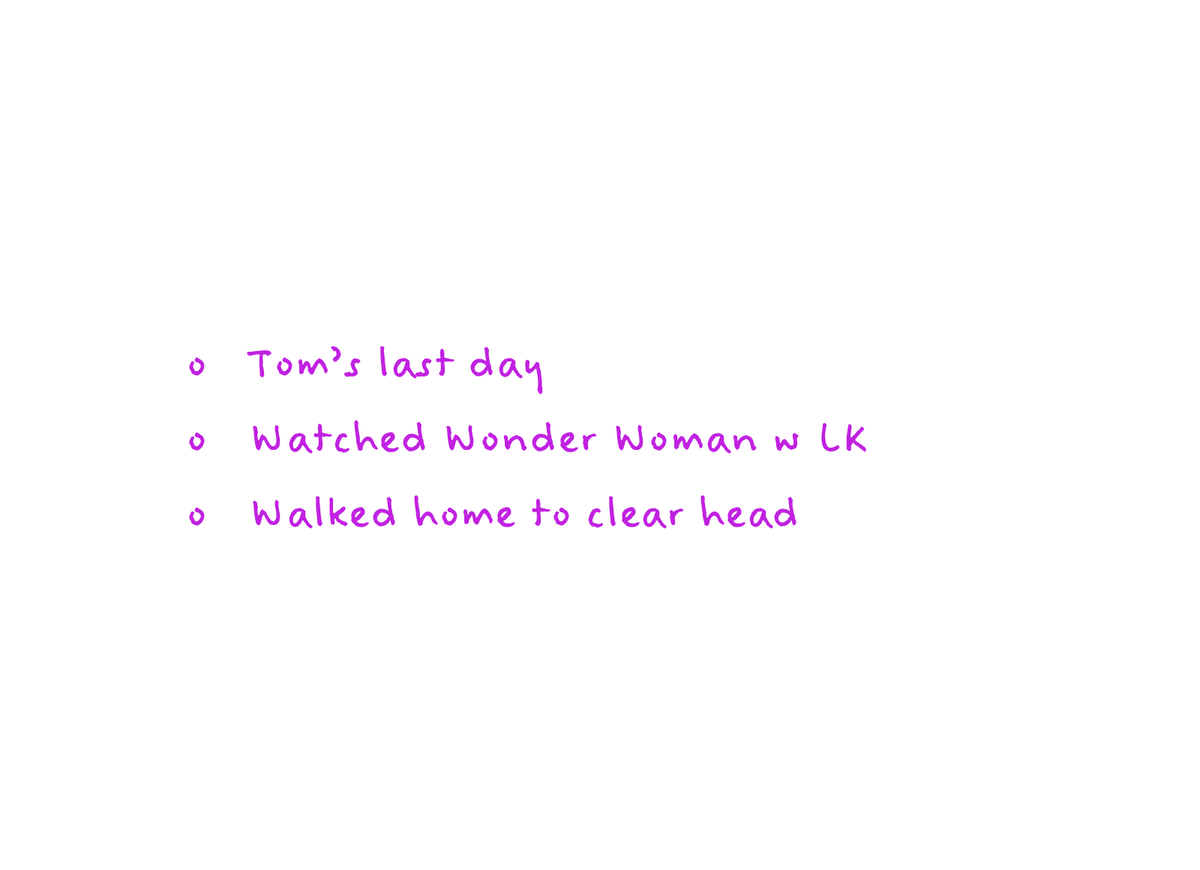
Events are represented by the open circle "O" Bullet. Events are date-related entries that can either be scheduled (e.g. "Charlie’s birthday") or logged after they occur (e.g. "signed the lease").
Our experiences can be complicated and distracting. Rather than trying to capture the way you feel in the moment, keep your Event entries short and objective. It will increase the odds of us writing them down. The important thing is to have a record of your experience so that you can learn from it.
事件用开放的圆圈子弹表示。事件是与日期相关的条目,可以是计划性的(如 "查理的生日"),也可以是在发生后记录的(如 "签订租约")。
我们的经历可能很复杂,也会让人分心。与其试图捕捉你当下的感受,不如让你的事件条目简短而客观。这将增加我们写下它们的几率。重要的是要记录下你的经历,这样你才能从中学习。
eg:
- ○ code review
- ○ merge day
- ○ fix bug: ...
Notes | 笔记
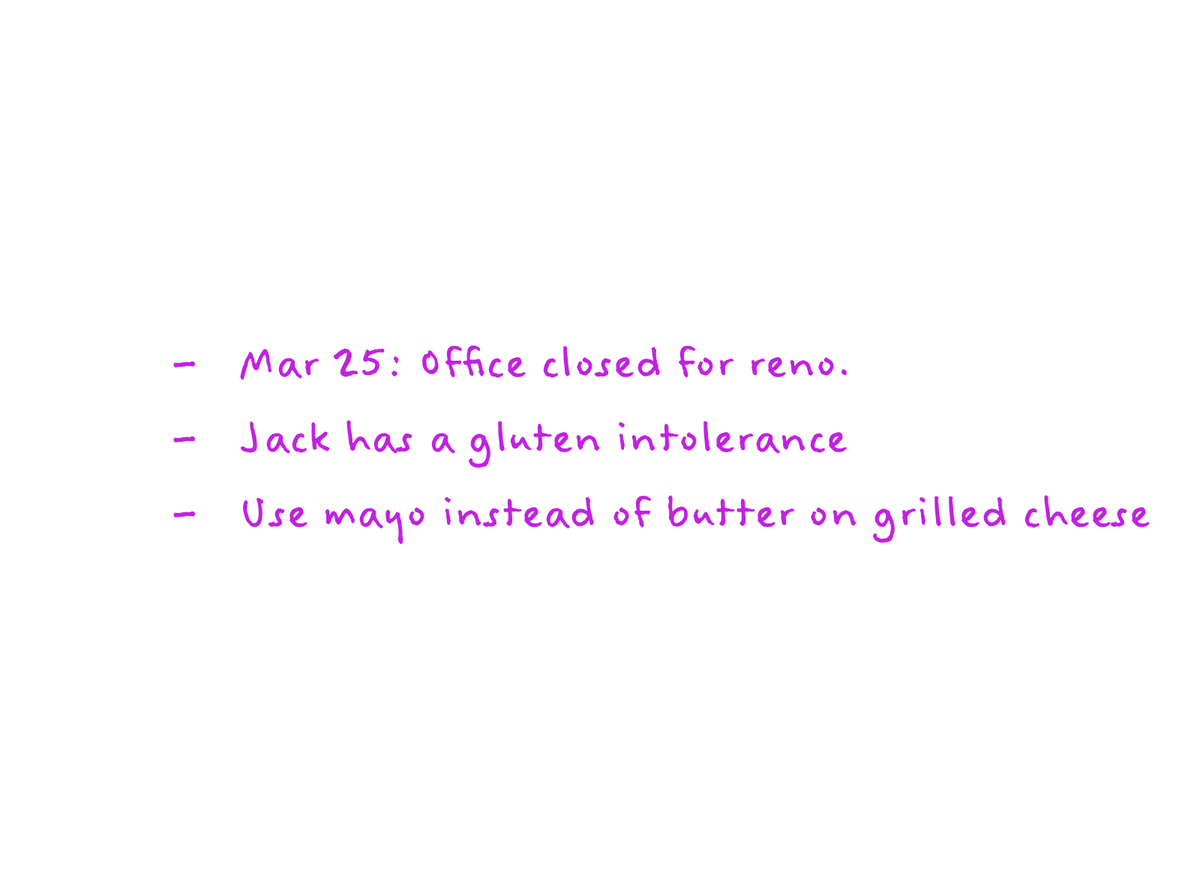
Notes are represented with a dash "–". Notes include: facts, ideas, thoughts, and observations. They're used to capture information or data you don't want to forget. This Bullet works well for meeting, lecture, or classroom notes.
注释用破折号"-"表示。笔记包括:事实、想法、思想和观察。它们用来捕捉你不想忘记的信息或数据。这种子弹很适合用于会议、演讲或课堂笔记。
eg:
- meeting notes: ...
- tech talk: ...
- note: ...
Mix & Match | 混合与搭配
Tasks, Events, and Notes will help you quickly capture your thoughts as they bubble up throughout the day. Don't worry about logging them in any particular order. The important thing is to get them out of your head, and onto the page.
任务、事件和笔记将帮助你快速捕捉你的想法,因为它们在一天中冒出。不要担心按照任何特定的顺序记录它们。重要的是把它们从你的脑海中赶出来,并记录在纸上。
Nesting | 嵌套
Nesting Bullets can add some much needed color to your entries. For example, nest Notes under an Event to capture important details. Nest subtasks under the main Task to break things down into a series of steps.
嵌套子弹可以为您的条目添加一些急需的色彩。例如,将 "备注 "嵌套在 "事件 "下面,以捕捉重要的细节。在主任务下嵌套子任务,将事情分解成一系列步骤。
Signifiers | 标识符
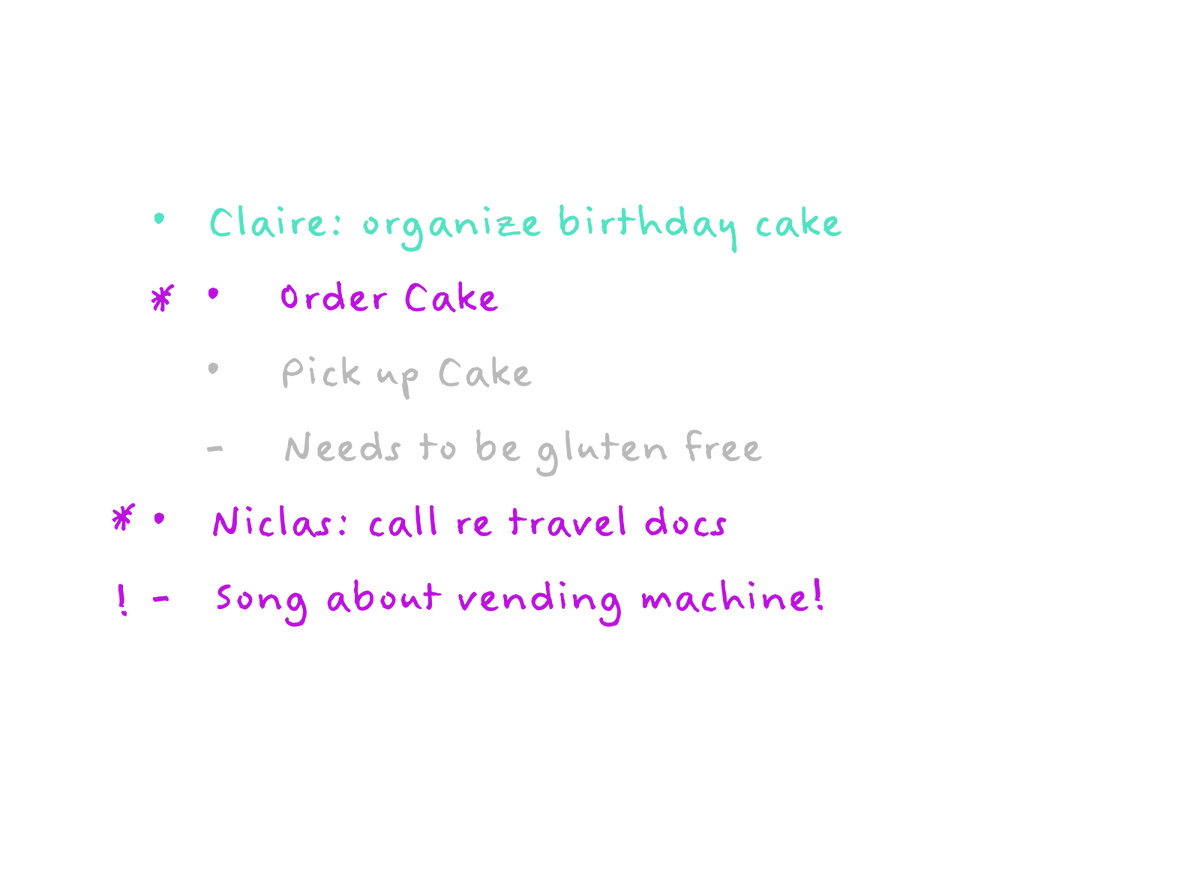
Signifiers are symbols that give your entries additional context at a glance. They're placed to the left of Bullets so they stick out, making them easy to spot when scanning your pages. Here are two useful examples, but feel free to come up with your own.
- = Priority: Used to mark the most important things on your list. Use it sparingly. If everything is a priority, nothing is.
! = Inspiration: Great ideas, personal mantras, and genius insights will never be misplaced again!
标识符是让您的条目一目了然的额外上下文的符号。它们被放置在子弹的左边,所以它们很突出,使它们在扫描页面时很容易被发现。这里有两个有用的例子,但也可以自由地想出你自己的例子。
- = 优先级。用来标记列表中最重要的事情。尽量少用它。如果每件事都是优先级,那就什么都不是了。
! = 灵感。伟大的想法,个人咒语,和天才的见解将永远不会再错失!
Putting it Together | 拼装
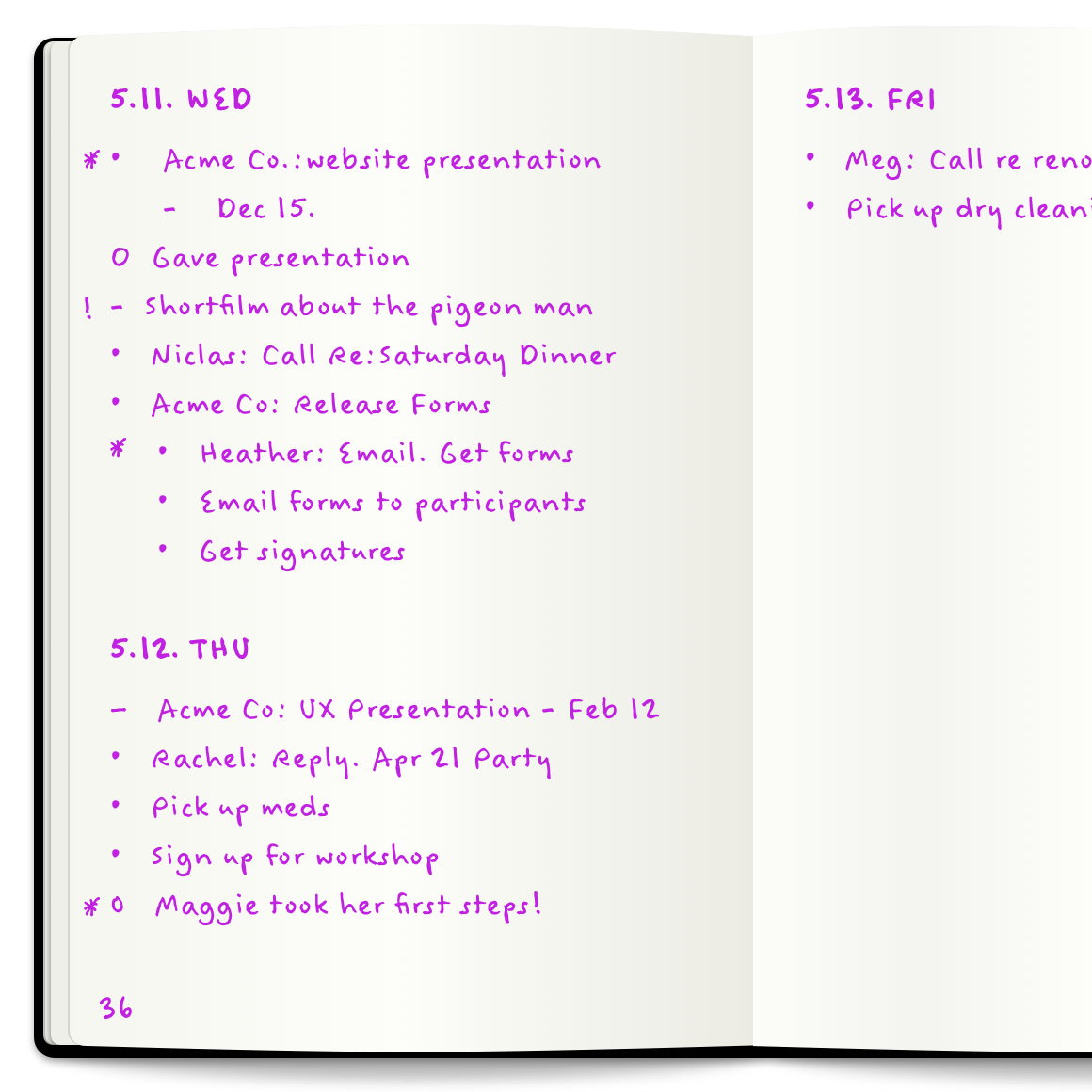
Start by giving your page a short descriptive Topic. This clarifies the purpose of the page and nature of its contents. In this example, it's simply the day's date.
Once that’s done, be sure to number the page. Page numbers will serve to locate your content.
This example is known as the Daily Log. It's the workhorse of the Bullet Journal, and one of the four main Collections.
首先给你的页面一个简短的描述性主题。这样可以明确页面的目的和内容的性质。在这个例子中,它只是简单的一天的日期。
完成后,一定要给页面编号。页面编号将起到定位你的内容的作用。
这个例子被称为 "每日日志"。它是 Bullet Journal的 主力军,也是四个主要 Collection 之一。
Collections | 集子
BuJo is a modular framework. Each module, or Collection, serves to organize related information. You can mix and match, customize, or even create Collections to best suit your needs. Let’s take a look at the four core Collections: The Index, Future Log, Monthly Log, and the Daily Log.
BuJo 是一个模块化的框架。每一个模块,或者说集子,都是用来组织相关信息的。你可以混搭、定制,甚至创建最适合你需求的集合。让我们来看看四个核心集子:
The Index, Future Log, Monthly Log, and the Daily Log.
The Index | 索引

The Index lives at the front of your notebook, and serves to locate content in your Bullet Journal. Simply add the Topics of your Collections and their page numbers to the Index, so you can quickly find them later.
Collections that span a series of consecutive spreads are indexed like this: "Collection Topic: 5-10."
Some Collections are recurring and can be spread throughout your notebook. These Collections can be indexed as such: "Collection Name: 5-10, 23, 34-39"
索引位于笔记本的前面,用于查找 Bullet Journal 中的内容。只需将您的收藏的主题和页码添加到索引中,您就可以在以后快速找到它们。
跨越一系列连续页数的集合,索引是这样的。"收藏主题: 5-10."
有些藏书是重复出现的,可以遍布整个笔记本。这些Collections可以这样索引:"Collection Name: 5-10"。"收藏名称: 5 -10, 23, 34 -39 5-10, 23, 34-39"
The Future Log | 未来日志

This Collection is used to store dated entries that will occur outside the current month. Provided is a simple six month template, but there are many other creative templates for setting up your Future Log.
Everything we task ourselves with is a potential experience. The Future Log serves as your time machine, allowing you to glimpse the outlines of the future you're actively working towards.
Tip: Each month, review your Future Log to see if anything can be migrated into the new Monthly Log.
该集合用于存储将发生在当前月份之外的日期条目。所提供的是一个简单的6个月的模板,但还有许多其他创造性的模板来设置你的未来日志。
我们给自己的任务都是一种潜在的体验。未来日志作为你的时间机器,让你可以瞥见你正在积极努力的未来的轮廓。
小贴士:每个月都要回顾你的 "未来日志",看看是否有什么可以迁移到新的 "月度日志 "中。
The Monthly Log | 月度日志

The Monthly Log is a spread of facing pages that consists of a Calendar and a Task page.
The Calendar Page This minimal calendar is designed to provide a birdseye view of the month. You can use it to schedule Events and Tasks, record Events after they happen, or both. Entries here should be as short as possible, as this page is designed for reference only.
The Task Page This page is designed to help you take a monthly mental inventory: What are the priorities for the month? What remains undone from last month? What matters now? Get it off your mind, and list it here.
Tip: Leave some room in the left margin of the page to add Signifiers to mark important entries.
月度日志是由日历页和任务页组成的单页。
日历页 这个最小的日历是为了提供一个鸟瞰式的月度视图而设计的,你可以用它来安排事件和任务,记录事件发生后的情况,或者两者兼而有之。你可以用它来安排事件和任务,记录事件发生后的情况,或者两者兼而有之。这里的条目应尽可能的简短,因为这个页面的设计只供参考。
任务页 本页旨在帮助你每月进行一次心理盘点。这个月的优先事项是什么?上个月还有哪些事情没有做完?什么是现在最重要的事情?把它从脑海中删除,然后在这里列出。
小贴士:在页面的左边空白处留出一些空间来添加标志符,以标记重要条目。
Daily Log | 每日日志

The Daily Log is designed for day-to-day use. At the top of the page, record the date as your topic. Throughout the course of the day, simply Rapid Log your Tasks, Events, and Notes as they occur. If you don’t fill a page, add the next date wherever you left off and you’re ready to continue.
Tip: Don’t set up Daily Logs way ahead of time. Create them as you go or the night before. You never know how much space you may need any given day.
每日日志是为日常使用而设计的。在页面顶部,记录日期作为您的主题。在一天的过程中,只需在任务、事件和笔记发生时快速记录它们。如果你没有填满一页,在你离开的地方添加下一个日期,你就可以继续了。
小贴士:不要提前设置每日日志的方式。在你走的时候或前一天晚上创建它们。你永远不知道任何一天你可能需要多少空间。
Custom Log | 自定义日志

The Bullet Journal is designed to become whatever you need it to be, be it a fitness or fertility tracker, food log, diary, sketchbook etc. You're encouraged to design your own Custom Collections.
Figuring out what you need your Bullet Journal to be is an important part of the process, a process that begins with regularly examining how you're spending your time and energy. We form this habit through Migration.
子弹日记本可以根据你的需要,成为任何你需要的东西,无论是健身或生育跟踪器,食物日志,日记,素描本等。我们鼓励你设计自己的自定义收藏。
想清楚你需要你的子弹笔记是什么是一个重要的部分,这个过程从定期检查你如何花费时间和精力开始。我们通过 "迁移 "形成这种习惯。
Migration | 迁移
We lead busy lives, but being busy doesn't necessarily mean we're being productive. Productive means that we're using our time wisely by focusing on what matters. Monthly Migration helps us accomplish this by weeding out distractions.
At the very end of each month, set up a new Monthly Log. Once that's done, review the pages of the month gone by. Chances are, you didn't get around to completing all your Tasks. That's fine! What's important is figuring out which incomplete Tasks are worth your limited time and energy moving forward. Strike out those that aren't, and migrate the ones that are.
To Migrate a Task, simply turn the "•" into ">" to indicate that you’ve moved that Task forward onto the Task Page of your new Monthly Log or into an appropriate Collection. If you wrote down a book title for example, you would migrate that entry into your "Books to Read" Collection.
Once you've Migrated open Tasks, check your Future Log. See if any Tasks or Events listed there have become current. If so, migrate those entries from your Future Log into your new Monthly Log.
It may seem like a lot of effort to have to rewrite all these things, but that’s intentional. This process makes you pause and consider each item. If an entry isn’t even worth the effort to rewrite it, then it’s probably not that important. Get rid of it. The purpose of Migration is to surface what's worth the effort, become aware of our actions, and to separate the signal from the noise. This is where BuJo shifts from a system, into the practice...
我们过着忙碌的生活,但忙碌并不一定意味着我们的生产力。生产力意味着我们将注意力集中在重要的事情上,从而明智地使用我们的时间。每月迁移可以帮助我们通过排除杂念来实现这一目标。
在每个月的月底,建立一个新的月度日志。完成后,回顾一下这个月过去的页面。很有可能,你没有完成所有的任务。这很好!最重要的是要弄清楚自己的任务。重要的是找出哪些未完成的任务值得你花有限的时间和精力去完成。剔除那些不值得完成的任务,并迁移那些值得完成的任务。
要迁移一个任务,只需将"-"变成">",就表示你已经将该任务移到了新的月度日志的任务页上,或者移到了一个合适的集合中。例如,如果您写下一本书的书名,您将把该条目迁移到您的 "要读的书 "集子中。
一旦你迁移了打开的任务,检查你的未来日志。看看那里列出的任何任务或事件是否已经成为当前。如果有,将这些条目从未来日志迁移到新的月度日志中。
要重写所有这些东西可能看起来很费劲,但这是故意的。这个过程会让你停顿下来,考虑每一个条目。如果一个条目根本不值得你花力气重写,那么它可能就没那么重要。把它扔掉吧。迁移的目的是将值得努力的东西浮出水面,意识到我们的行为,并将信号从噪音中分离出来。这就是 BuJo 从一个系统转变为实践的地方...
Templates¶
Note
# TOPIC
**SUBTOPIC 1**
* Key point 1
* Key point 2
* Key point 3
- Extra information
- Examples
- Studies/reasearch findings
**SUBTOPIC 2**
* Defintion
* Key point 1
Review
**Review**
- do something
**Next**
- to fix
Notion 实践¶
创建一个 Calendar view
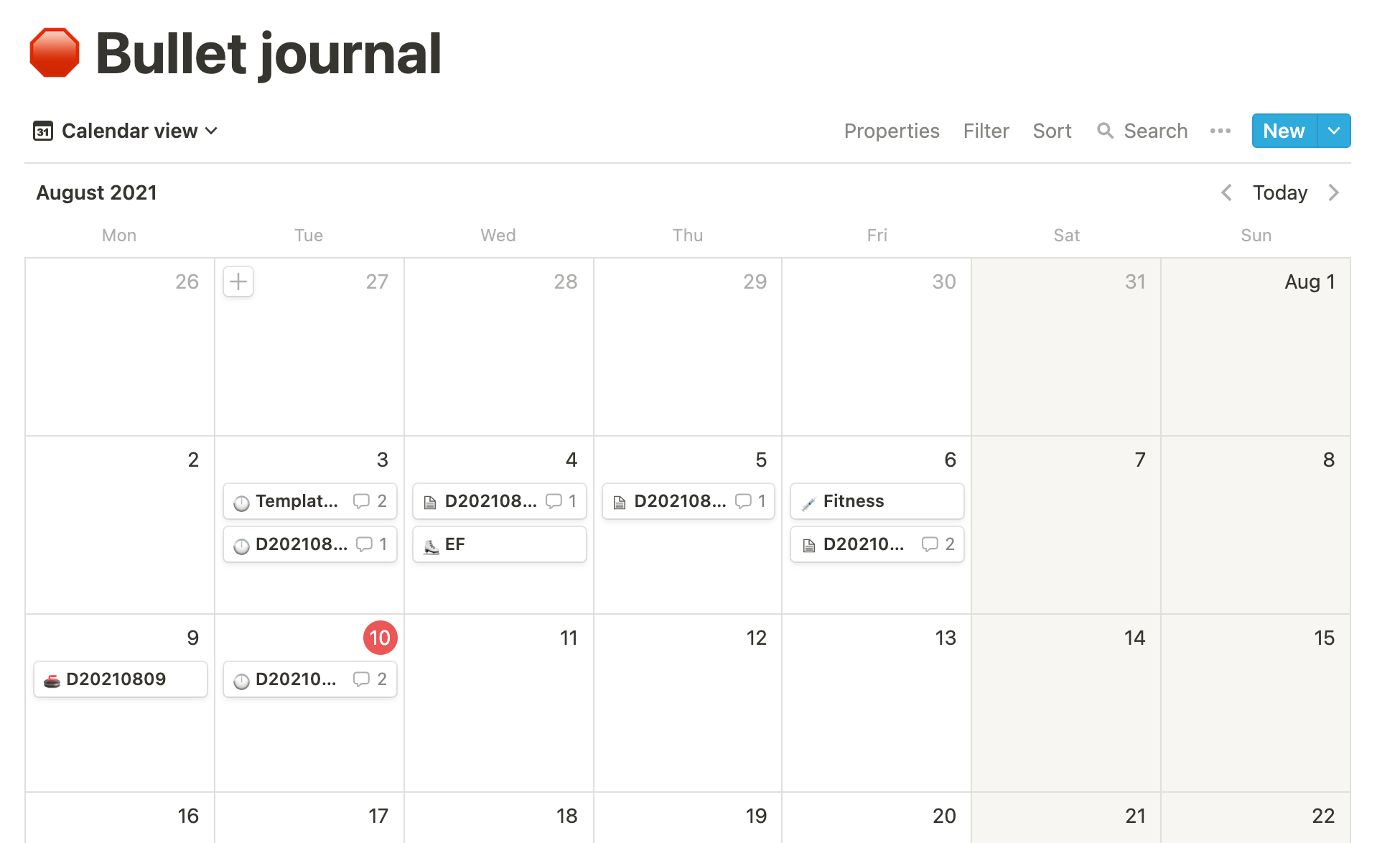
创建一个 Archive view
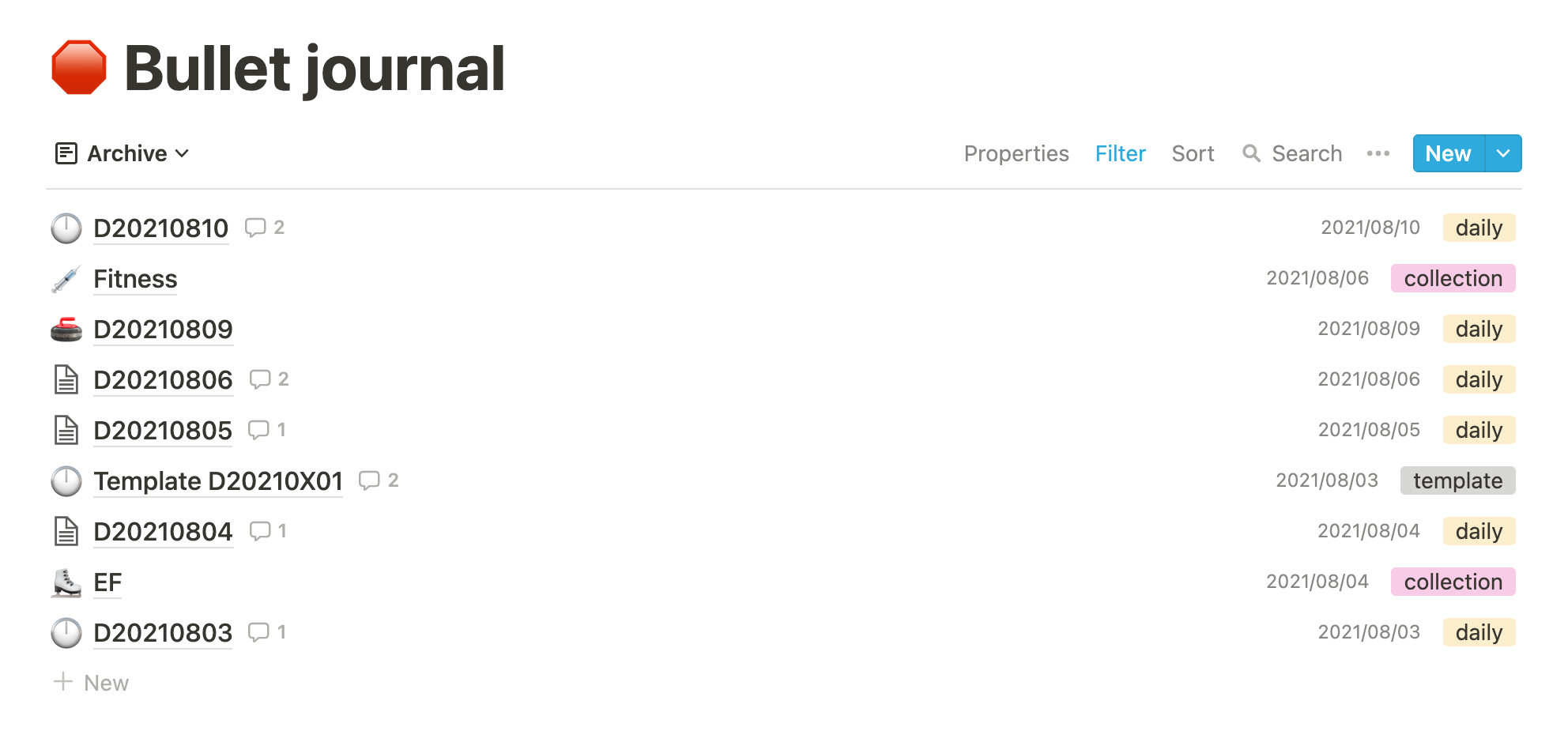
我的模版

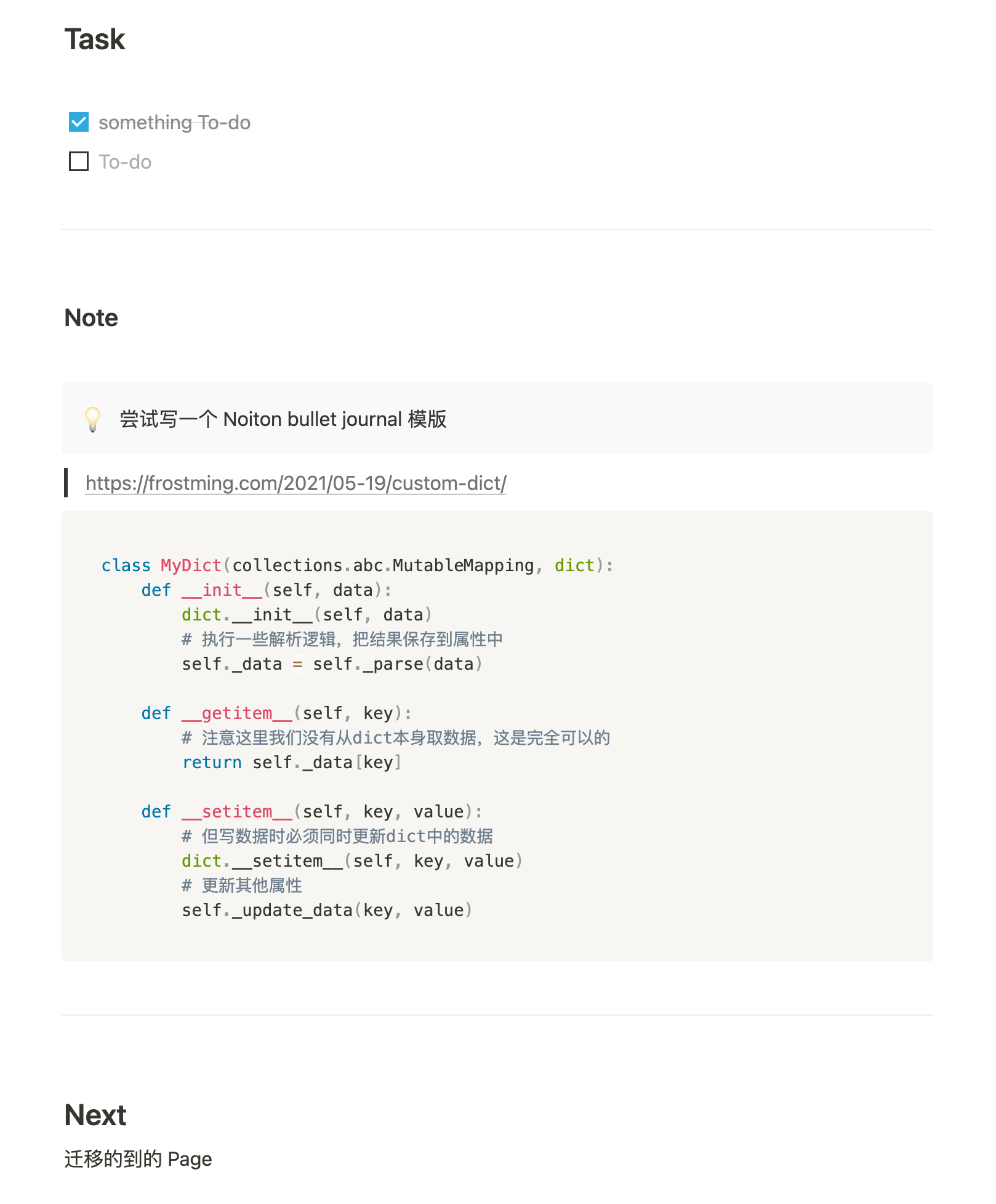
Reference¶
创建日期: 2021-03-04